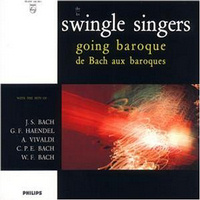The SWINGLE SINGERS
Going Baroque
de Bach aux baroques

(1964)

1. Badinerie 1'21 Johann Sebastian BACH
2. Aria And Variations: "The Harmonious Blacksmith" 2'26 George Fridrich HAENDEL
3. Giga 1'22 Johann Sebastian BACH
4. Largo 3'03 Johann Sebastian BACH
5. Prelude No. 19 in A major 1'11 Johann Sebastian BACH
6. Praeambulum 2'28 Johann Sebastian BACH
7. Fugue 2'24 Antonio VIVALDI,
8. Allegro 3'17 George Friedrich HAENDEL
9. Prelude No. 7 in E flat major 2'42 Johann Sebastian BACH
10. Solfegietto in C minor 0'57 Carl Philipp Emanuel BACH
11. Der Fruehling (Spring) 1'36 Wilhelm Friedemann BACH
12. Prelude No. 24 in B minor 1'56 Johann Sebastian BACH
Total Time: 24:43
Getting Romantic

(1965)

(1965)

1. Scherzo (Sonata for Violin and Piano op. 24 No. 5 in F major "Spring") 1'14 Ludwig van BEETHOVEN
2. Allegro (Piano Sonata op. 26 No. 12 in A Flat major) 2'35 Ludwig van BEETHOVEN
3. Etude op.10 No. 6 in E flat major 3'29 Frederic CHOPIN
4. Etude op.25 No. 2 in F minor 1'31 Frederic CHOPIN
5. Waltz op.64 No. 2 in C sharp minor 3'16 Frederic CHOPIN
6. Short Fugue (Album For The Young op.68) 2'13 Robert SCHUMANN
7. Spinning Song (Songs Without Words op. 67 No. 4) 2'03 Felix MENDELSSOHN-BARTHOLDY
8. Limoges, The Market (Pictures At An Exhibition) 1'26 Modest MUSSORGSKY
10. Andante (String Quartet op.44 No. 1 in D major) 3'32 Felix MENDELSSOHN-BARTHOLDY
11. Zortzico 2'08 Isaac ALBENIZ
12. Andante (String Quartet op.29 No. 13 in A minor D.804 "Rosamunde") 5'13 Franz SCHUBERT
Total Time: 28:40
![]()